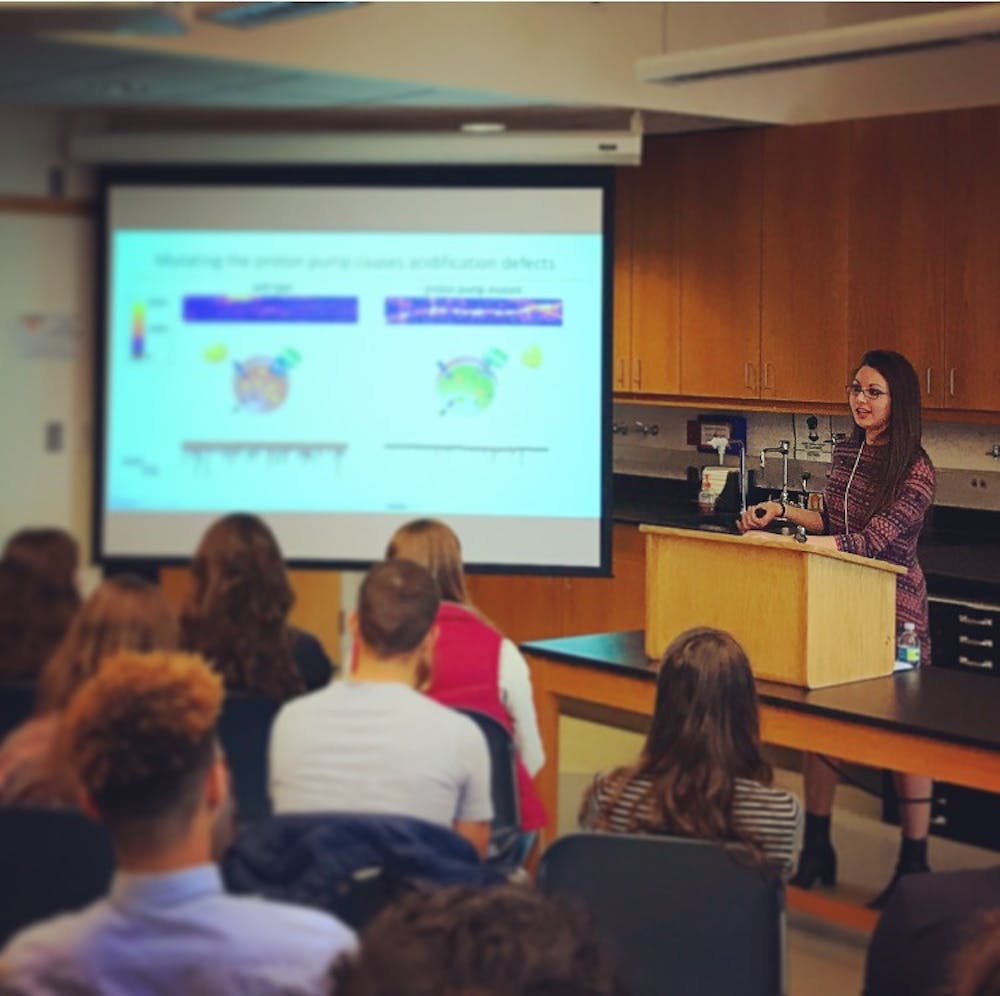As the 2016–17 academic year slowly draws to a close, McCardell Bicentennial Hall remains abuzz with activity, as senior thesis presentations are in full swing. Many soon-to-be graduates of the biology, neuroscience, chemistry & biochemistry, molecular biology & biochemistry and conservation biology departments have spent the greater part of the past year in the lab or the field, working diligently to produce independent research with various professors at the College.
While the chemistry & biochemistry department indulges its devoted students in three to four hour-long sessions on Friday afternoons (an extravaganza more fulfilling than binge-watching The Office), the biology-focused departments prefer to sprinkle their presentations across the lunch hour throughout the past week. For this issue, three particular student presentations are featured: Eric Stanton, Julie Merchant and Laura Bashor.
Eric Stanton ’17, a biochemistry major working in Professor Jeff Byers’s lab, presented his work entitled “Synthesis of a Chromium Complexed Poly-(p-phenylene ethynylene) Polymer as a Potential Molecular Wire” on Friday, May 5. Using the organic synthesis techniques characteristic of the Byers lab, he described the steps taken that enabled him to construct a complexed p-phenylene ethnylene (PPE) polymer starting from dichlorobenzene.
Stanton then moved into the results of his work. When he assayed the stability of his synthetic polymer with NMR, a common chemical laboratory technique, he was surprised to see that his complex was not as stable as expected. Stanton then performed fluorescent quenching, which involves exposing polymers to UV light and measuring the excited state charge transfer. While Stanton’s polymer did not display the stability that he had hoped, he found that fluorescent quenching provided a better model to understand this complex.
On Monday, May 8, Julie Merchant ’17 and Laura Bashor ’17 both presented during the lunch hour, representing the biology department. After a jovial and entertaining introduction from her advisor Professor Glen Ernstrom, Merchant kicked off the session with her dynamic presentation of “Optogenetic acidification of synaptic vesicles in C. elegans.” She explored how neurons communicate, which led naturally into a brief but thorough review of neurotransmission and a helpful analogy connecting neuronal communication to a water balloon fight.
Merchant’s research focuses on understanding the importance of vesicle pH in regulating the transport of neurotransmitters into synaptic vesicles. When these synaptic vesicles are only partially filled, they are less likely to fuse with target cells into which the neurotransmitters are meant to be delivered. This results in pronounced behavioral defects such as deficits in motor coordinates and balance.
Her hypothesis was that the acidification provides a molecular checkpoint that instructs vesicles to fuse properly. Through a variety of experiments, she was able to demonstrate that a proton pump-deficient C. elegans mutant has diminished vesicle fusion. Merchant was also able to restore an acidification-related defect in said C. elegans mutant by expressing a protein on the vesicle surface that acidifies the vesicle in response to light stimulus.
In a brief introduction, Allen mentioned that Bashor would soon be presenting her work to the Ecological Society of America. Bashor’s thesis project, “Lyme disease and elevation: a dynamic ecological relationship,” focused on work she had been pursuing in Professor David Allen’s laboratory since the summer. She opened with an array of statistics depicting the stark increase of Lyme disease cases in the United States, and particularly Vermont. In an effort to untangle the ecology of Lyme disease, Bashor addressed the fact that although the black legged tick is the most infamous of Lyme disease carriers, other small mammals could actually be implicated as the biggest contributors to human infection.
At the heart of Bashor’s work was the connection between elevation and Lyme disease risk, as the life cycles of the black legged tick and various small mammals are in turn determined by such environmental factors. Along an elevational gradient, Bashor collected ticks, the white footed mouse and deer mouse and tried to identify elevation’s effect on the distribution of Lyme disease infection rates. She found in her samples that, although the white-footed mouse is thought of as a more common vector for Lyme disease, the deer mouse actually was infected with Lyme disease at a much higher rate. In addition, she observed differences in the activity and densities of the black legged tick along an elevational gradient, implicating that the ecology of Lyme disease is tied inherently to elevation.
While these three presentations represent only a small subset of the talks that have been given over the past few weeks, they provide a brief glance at the diligent work that happens behind closed lab doors.




